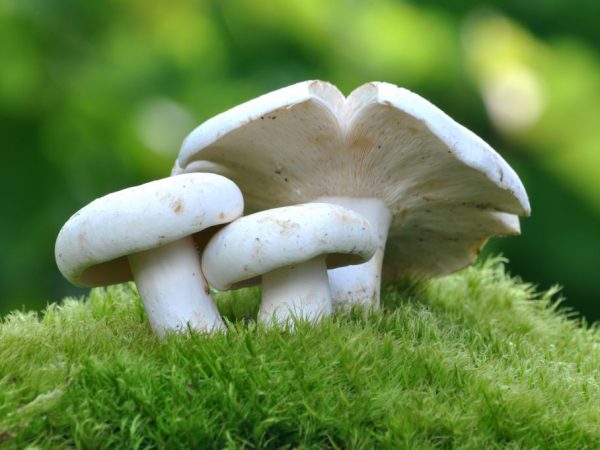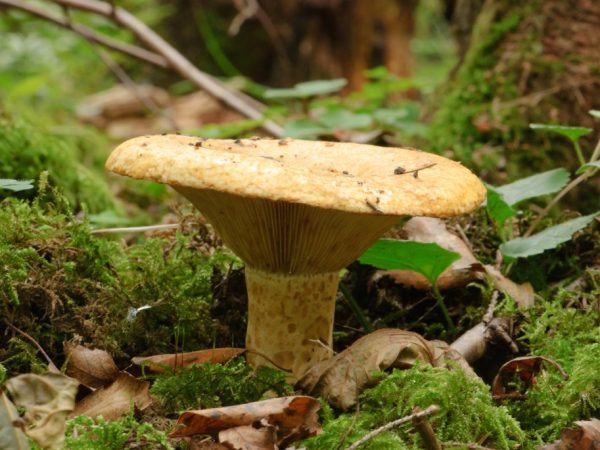Types of false milk mushrooms
The false milk mushroom is easy to find, but there are mushrooms similar to it. Among them there are edible and toxic ones. Eating some false milk mushrooms is fatal. White milk mushroom has a number of useful substances, when properly prepared, it has a pleasant aroma and taste.
- Features of milk mushrooms
- Differences from other mushrooms
- Difference from squeak
- Difference from dry weight
- Difference from bitterness, or a load of pepper
- Difference from thin pig
- Difference from spruce rowing
- Difference from whites of whites
- Difference from pale toadstool
- Difference from the milkman
- Mushroom picking
- Conclusion

Types of false milk mushrooms
Features of milk mushrooms
A false weight from the present is determined based on external qualities:
- round cap with a compressed center up to 20 cm, always wet, slimy;
- the shape of the cap is funnel-shaped;
- color is white, yellowish;
- brown spots are present;
- plates are white or yellowish. The plates determine the quality and age of the fungus;
- the flesh is white, firm and fleshy;
- pungency in taste and smell;
- a lot of milky juice, it is absent only in dry weight.

The false lump differs from the real one in appearance
Differences from other mushrooms
According to the description, the real milk mushroom has a lot of false varieties. Many of them are eaten, but there are also poisonous ones.
Difference from squeak
It is difficult to distinguish a white lump from a squeak, even for an experienced specialist.
Squeaky is edible, similar to a white lump, but the taste is different. It also has beneficial properties. The main differences are:
- it is called a squeak because of the special squeak when parts of the fruit bodies come into contact;
- these false counterparts appear later than the present ones;
- worms settle only in white milk mushrooms, they do not start in the squeak pulp;
- plates are less fleshy, light and thinner in white.
Difference from dry weight
False black milk is popularly called "nigella", "dry" or "chameleon".
He has a different color of the cap, depending on the age of the mushroom. It is initially white, but turns brown over time. There is no milky juice. Features of dry weight:
- needs a well-lit place;
- lives in mixed and birch forests;
- dry hat;
- the fossa at the apex is deeper.
Difference from bitterness, or a load of pepper
The white milk mushroom differs from the false one also in the place of growth. Gorchak is found in the North in the forests. Grows in large groups in well-moisturized areas.
Irina Selyutina (Biologist):
The peppercorn is characterized by a creamy white dry cap in the form of a funnel, as well as an abundant release of white milky juice, which turns bluish or olive green in the air and a specific very pungent peppery taste that disappears only after thorough soaking.
The cap is up to 8 cm in diameter. The surface is flat, convex in young organisms, and funnel-shaped in mature ones. The plates are pale, yellow and red, with a bloom. Leg up to 8 cm. Milky sap is bitter. The taste is spicy and bitter, therefore this mushroom is only salted. It is classified as conditionally edible.
Difference from thin pig
A thin pig is a poisonous species, poisoning with it leads to death.Symptoms appear several hours after eating this mushroom.
The difference between a real mushroom and a pig in a hat, which has its own characteristics:
- size - up to 20 cm;
- the edges are directed inward;
- covered with fine hairs;
- color olive, brown, yellow.
Irina Selyutina (Biologist):
On closer examination of the underside of the cap of a thin pig, or rather a hymenophore, one can notice that it is folded, not lamellar, although it is often described in various sources as lamellar. It is formed not by real, but by pseudo-plates. It is easy to separate it from the surface of the cap, which is not possible with real plates. The color of the pseudo-plates is usually lighter than the color of the cap. Under mechanical action - pressure, they darken.
The flesh of the pig is brown; it darkens at the site of the cut. Leg up to 9 cm, directed sideways. Tapers towards soil. Harvesting is carried out from mid-summer to mid-autumn.
The false lump is larger, its leg is brown. It accumulates a large amount of heavy metals.

There are false varieties of real milk mushrooms.
Difference from spruce rowing
Difference from spruce rowing in pulp. It is firmer, whiter, smells like flour, and tastes bland. The plates of the false fungus are white, then (as the fungus grows) they become yellow or blue.
The leg at the row reaches 10 cm in height and 2 cm in width. It is flat and white. The row is edible, it is used for cooking many dishes.
Grows in coniferous forests from late summer until the first cold weather. The groups are small. Rarely collected. The size of the cap reaches 10 cm. The surface is sticky, gray in color. It is darker in the center than at the edges.
Difference from whites of whites
White whites grow in the Center, in the North, West, and also in the Urals. Harvesting begins from early August to mid-autumn. One of the differences is the appearance of the hat. The white woman has a velvety white hat with a diameter of up to 6 cm, with red spots.
The main difference is in the pulp, in a real mushroom it is always white, while in a wave it is pink. The size of the cap of the whiteness is smaller, it has drooping bare edges. It is used only for salting, before that it must be carefully prepared.
Difference from pale toadstool
Toadstool has a slight thickening near the base of the leg. The appearance is more like russula.
A toadstool can have an olive green or white hat. A ring on the leg is located directly under the cap.
Difference from the milkman
The miller is like a white lump. It is a poisonous species, its use leads to death. The hat is up to 12 cm in size. It is fleshy, convex and funnel-shaped.
The edges are bent at first, and lower with age. The old milkman is red or pink. The leg reaches 8 cm in length and 4 cm in width. It occurs from mid-summer to early autumn.
Mushroom picking
Each type of mushroom has its own characteristics in terms of the place of growth, soil, light and humidity. The mushroom grows:
- in the middle-aged forest. In the young they do not have time to appear, but in the old they overgrow;
- the grass near the trees should be low; in a high yield it is less common;
- harvested after rain, in the morning with dew;
- in the places of growth, a characteristic mushroom smell is felt.
Timing of collecting milk mushrooms:
- black is harvested in mid-summer and before autumn;
- blue gathers throughout August;
- oak and aspen are harvested from late July to early autumn;
- yellow and peppercorns are harvested from July until late summer.
All terms are conditional. The climate and soil must be moist when harvesting.
Conclusion
It is not difficult to find a false lump if you know the features of its appearance. Most often, a real milk mushroom differs from a false one in the color of the cap and in the shape. The hat is always slimy and soft. The pulp is white in color. Also look at the location where the mushrooms grow. Dry soils and climates are not suitable for the development of mushrooms. Therefore, it is important to know the ecological characteristics of the species when going to the forest.
If the mushroom is in doubt, it is better not to collect it. Only true whites can be wormy, false ones look perfect. True milk mushrooms have a large amount of milky juice.



